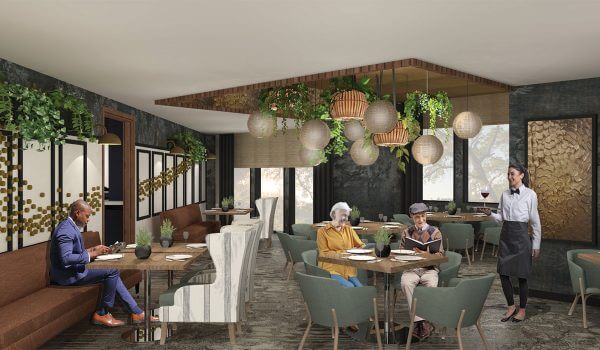Six years ago, we began concepting a new type of senior community with the goal of reinventing the look and feel of senior living. Our team’s design backgrounds mainly included experience in market-rate multifamily properties, high-concept leasing and cultural galleries, and hospitality, so we approached senior living with zero pre-conceived notions. We started the process by reading Healing Spaces by Dr. Esther Sternberg and diving into the psychographics of the boomer sub-generations. Our research could be summed up in a couple of key items: The generations that are arguably the most interesting in our society were being reduced to a dangerous stereotype, and these spaces, when designed strategically, can help prolong the “active” years of aging. These generations are becoming the “age of reinvention” and pose an exciting demographic to research and design for.
When we speak of dangerous stereotypes in design, we are referring to outdated mindsets that can hinder our thought process and block our ability to provide appropriate solutions. Or, more commonly, we misinterpret that “form following function” means it is simply an afterthought and not an integral part of the human connection. Sergei Scherbov, deputy director at The International Institute for Applied Systems Analysis, pointedly said, “What we think of as old has changed over time, and it will need to continue changing in the future as people live longer, healthier lives.” When designing for seniors, we have approached the process like we would for any other demographic, while being especially mindful of universal design and classic aesthetics.
An example of this is the brand we created with The Wolff Company called “Revel.” Revel Communities focus on independence, connection and wellness. Each property is built from the ground up, offering tailored lifestyles to fit each resident with well-thought-out units and strategic, high-end amenities. They all feature a farm-to-table restaurant, bar/lounge and a lobby lounge, as well as core health amenities such as a wellness spa, fitness center and salon. In more recent Revel communities, each property features a flex amenity that is unique to each location, such an ice cream parlor or convenience market. The approach to accessibility was to incorporate it into the design in a way that felt natural and inclusive as opposed to clinical and exclusive, to allow the spaces to feel ageless and comfortable for all residents and their guests. Materials were specifically selected to appeal to all ages as well as aid in memory retention, wayfinding, comfort and sense of place.
A concept that was also introduced as part of the Revel brand is a resident senior program, the first of its kind for senior living properties. As part of the program, residents can choose a three- or six-month stay at any of the other Revel locations in a furnished, pet-friendly, one-bedroom apartment, like an Airbnb experience. This allows the residents a safe and familiar way to travel.
When addressing senior living, there are many different types of properties with varying levels of medical needs. However, we strongly feel that these residents deserve to age gracefully and the design of the spaces they spend their time in should be as interesting and culturally rich as they are.
New in Scottsdale, Revel Scottsdale and Revel Legacy are scheduled to open this summer; we are in the final stages of installation at these two Revel Communities.
